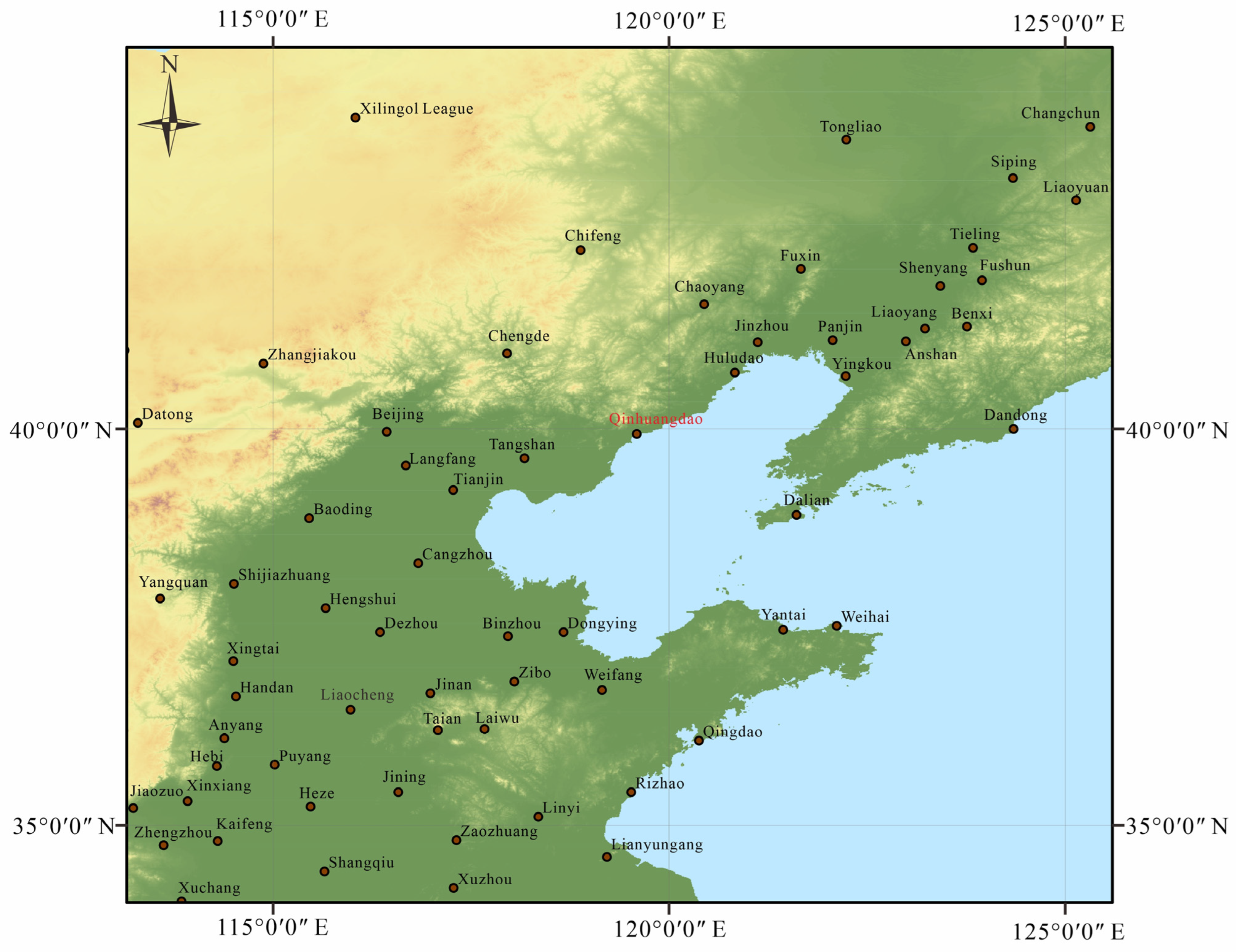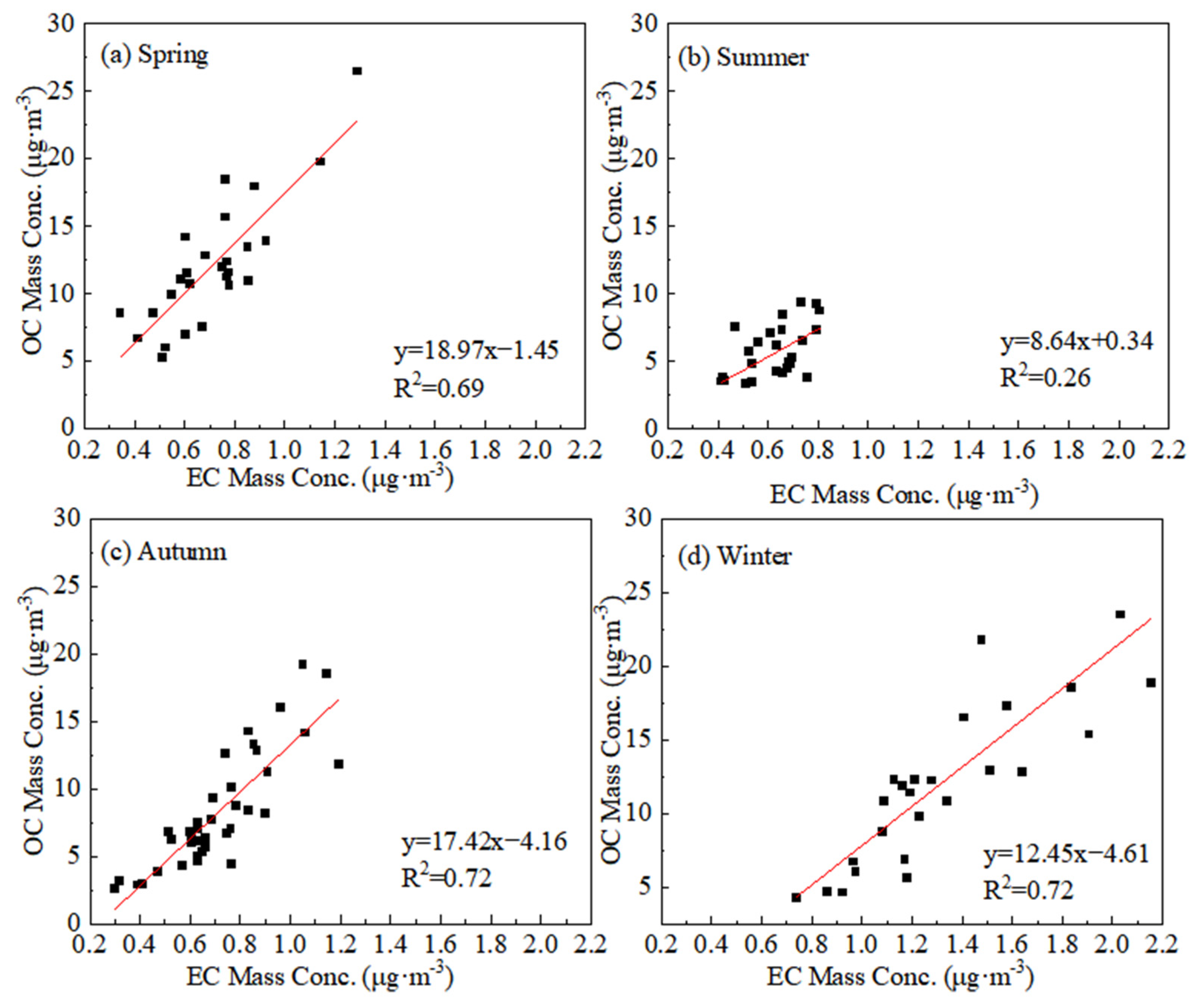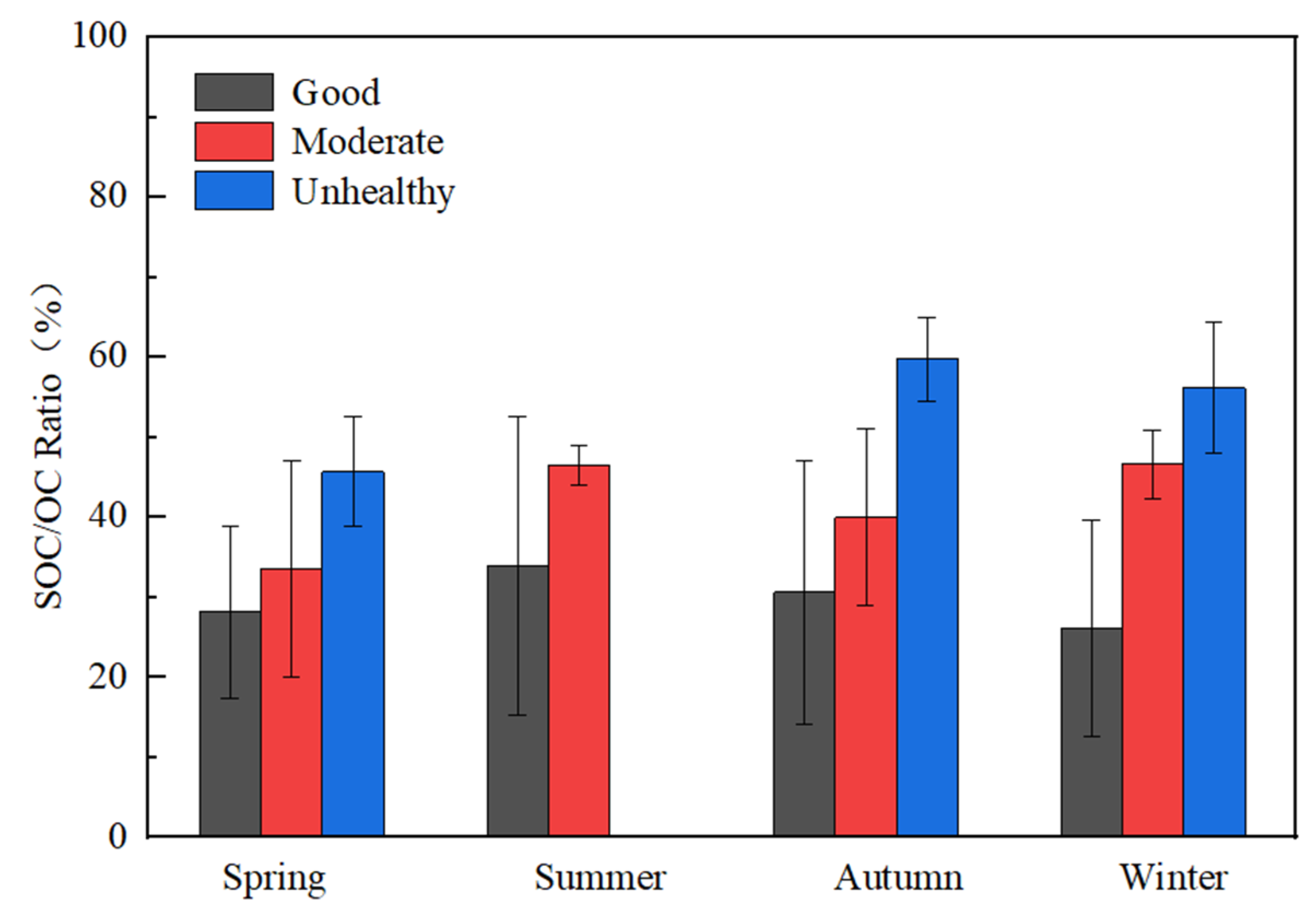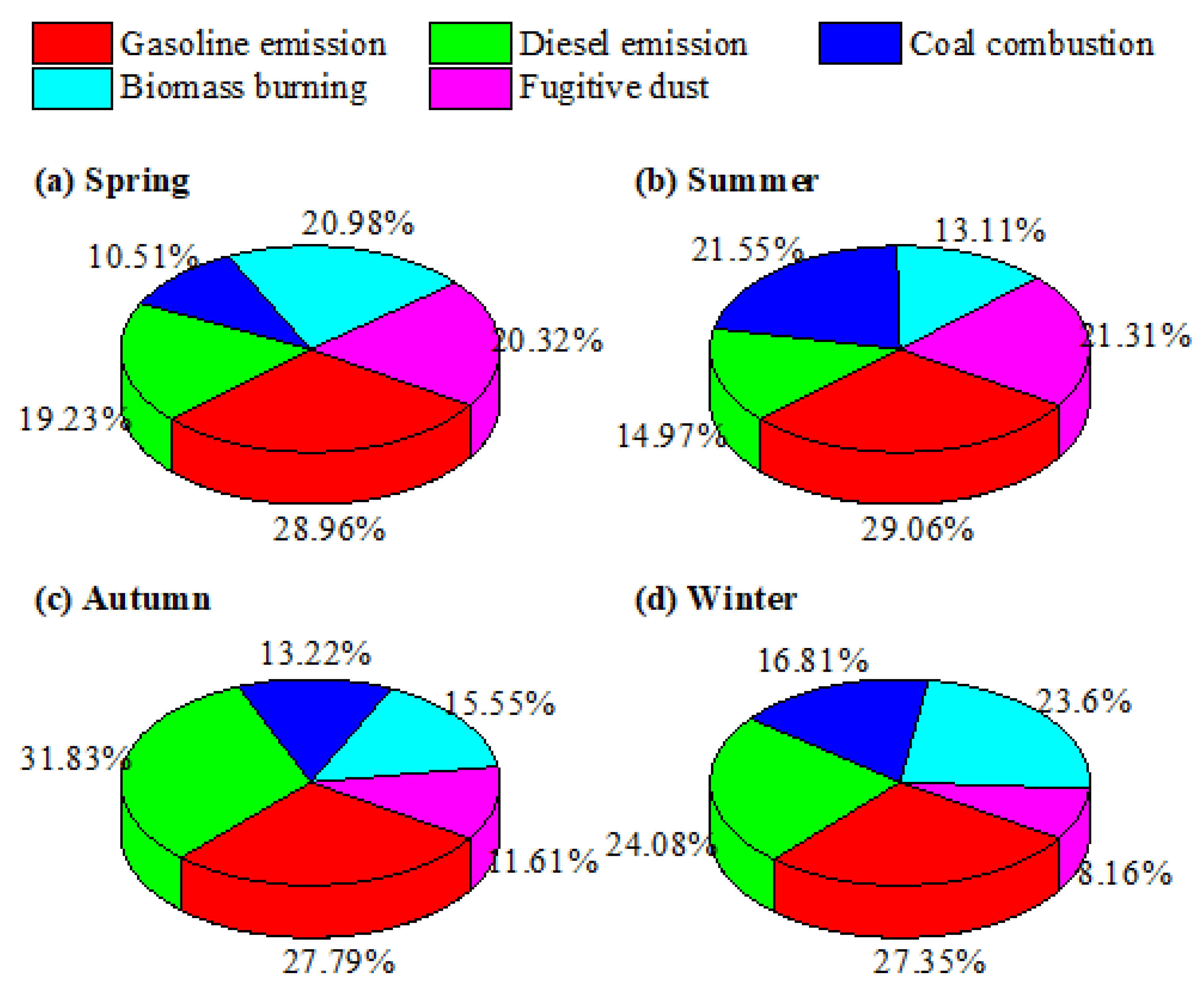Seasonal Variations of Carbonaceous Aerosols of PM2.5 at a Coastal City in Northern China: A Case Study of Qinhuangdao
Abstract
1. Introduction
2. Materials and Methods
2.1. Sample Collection
2.2. Sample Analysis
2.3. Secondary Organic Carbon Estimation
2.4. PMF Model
3. Results and Discussions
3.1. Mass Concentrations of OC and EC
3.2. Correlations Between OC and EC, and SOC Estimation
3.3. Source Apportionment of Carbonaceous Aerosols
4. Conclusions
5. Outlook
Supplementary Materials
Author Contributions
Funding
Institutional Review Board Statement
Informed Consent Statement
Data Availability Statement
Conflicts of Interest
References
- Huang, J.; Zhang, Z.; Tao, J.; Zhang, L.; Nie, F.; Fei, L. Source apportionment of carbonaceous aerosols using hourly data and implications for reducing PM2.5 in the Pearl River Delta region of South China. Environ. Res. 2022, 210, 112960. [Google Scholar] [CrossRef]
- Tao, J.; Zhang, L.; Cao, J.; Zhang, R. A review of current knowledge concerning PM2. 5 chemical composition, aerosol optical properties and their relationships across China. Atmos. Chem. Phys. 2017, 17, 9485–9518. [Google Scholar] [CrossRef]
- Li, M.; Hu, M.; Walker, J.; Gao, P.; Fang, X.; Xu, N.; Qin, Y.; Zhou, L.; Liu, K.; Czimczik, C.I.; et al. Source apportionment of carbonaceous aerosols in diverse atmospheric environments of China by dual-carbon isotope method. Sci. Total Environ. 2022, 806, 150654. [Google Scholar] [CrossRef]
- Paisi, N.; Kushta, J.; Pozzer, A.; Violaris, A.; Lelieveld, J. Health effects of carbonaceous PM2.5 compounds from residential fuel combustion and road transport in Europe. Sci. Rep. 2024, 14, 1530. [Google Scholar] [CrossRef]
- Schwarz, J.; Cusack, M.; Karban, J.; Chalupníčková, E.; Havránek, V.; Smolík, J.; Ždímal, V. PM2.5 chemical composition at a rural background site in Central Europe, including correlation and air mass back trajectory analysis. Atmos. Res. 2016, 176–177, 108–120. [Google Scholar] [CrossRef]
- Han, Y.M.; Cao, J.J.; Lee, S.C.; Ho, K.F.; An, Z.S. Different characteristics of char and soot in the atmosphere and their ratio as an indicator for source identification in Xi’an, China. Atmos. Chem. Phys. 2010, 10, 595–607. [Google Scholar] [CrossRef]
- Niu, H.; Liu, Z.; Hu, W.; Cheng, W.; Li, M.; Xue, F.; Wu, Z.; Wang, J.; Fan, J. Carbonaceous components in particulate matter during a haze episode at a typical industrial area in the North China Plain. World J. Eng. 2021, 18, 293–301. [Google Scholar] [CrossRef]
- Huang, R.J.; Zhang, Y.; Bozzetti, C.; Ho, K.F.; Cao, J.J.; Han, Y.; Daellenbach, K.R.; Slowik, J.G.; Platt, S.M.; Canonaco, F.; et al. High secondary aerosol contribution to particulate pollution during haze events in China. Nature 2014, 514, 218–222. [Google Scholar] [CrossRef] [PubMed]
- Li, X.; Zhu, H.; Zhang, X.; Yang, Y.; Jiang, J.; Liu, Y.; Chen, J.; Tian, H.; Hou, D.; Liu, X. Characteristics of carbonaceous aerosols in four northern Chinese cities during the 2022 Winter Olympics. Atmos. Environ. 2024, 334, 120699. [Google Scholar] [CrossRef]
- Feng, T.; Wang, F.; Yang, F.; Li, Z.; Lu, P.; Guo, Z. Carbonaceous aerosols in urban Chongqing, China: Seasonal variation, source apportionment, and long-range transport. Chemosphere 2021, 285, 131462. [Google Scholar] [CrossRef] [PubMed]
- Park, G.; Kang, S.; Bae, M.-S.; Lim, Y.; Jeon, C.-S.; Lee, T. Roadside air pollution and secondary organic aerosol seasonal trends from an oxidation flow reactor in Seoul. Atmos. Environ. 2023, 312, 120051. [Google Scholar] [CrossRef]
- Jiang, G.; Song, X.; Xie, J.; Shi, T.; Yang, Q. Polycyclic aromatic hydrocarbons (PAHs) in ambient air of Guangzhou city: Exposure levels, health effects and cytotoxicity. Ecotoxicol. Environ. Saf. 2023, 262, 115308. [Google Scholar] [CrossRef] [PubMed]
- Bond, T.C.; Doherty, S.J.; Fahey, D.W.; Forster, P.M.; Berntsen, T.; DeAngelo, B.J.; Flanner, M.G.; Ghan, S.; Kärcher, B.; Koch, D.; et al. Bounding the role of black carbon in the climate system: A scientific assessment. J. Geophys. Res. Atmos. 2013, 118, 5380–5552. [Google Scholar] [CrossRef]
- Cheng, X.; Yu, J.; Chen, L.; Sun, Y.; Zhang, H.; Gao, S.; Kong, S.; Zheng, H.; Wang, H. Influence of pollution control measures on the reduction of black carbon in an urban site of megacity, Tianjin, China based on ground-monitored and MERRA-2 reanalysis data. Sci. Total Environ. 2024, 912, 169466. [Google Scholar] [CrossRef] [PubMed]
- Li, P.; Yue, S.; Yang, X.; Liu, D.; Zhang, Q.; Hu, W.; Hou, S.; Zhao, W.; Ren, H.; Li, G.; et al. Fluorescence Properties and Chemical Composition of Fine Particles in the Background Atmosphere of North China. Adv. Atmos. Sci. 2023, 40, 1159–1174. [Google Scholar] [CrossRef]
- Liu, Y.; Xu, X.; Ji, D.; He, J.; Wang, Y. Examining trends and variability of PM2.5-associated organic and elemental carbon in the megacity of Beijing, China: Insight from decadal continuous in-situ hourly observations. Sci. Total Environ. 2024, 938, 173331. [Google Scholar] [CrossRef]
- Dong, Z.; Li, X.; Dong, Z.; Su, F.; Wang, S.; Shang, L.; Kong, Z.; Wang, S. Long-term evolution of carbonaceous aerosols in PM2.5 during over a decade of atmospheric pollution outbreaks and control in polluted central China. Sci. Total Environ. 2024, 935, 173089. [Google Scholar] [CrossRef]
- Dao, X.; Ji, D.; Zhang, X.; He, J.; Sun, J.; Hu, J.; Liu, Y.; Wang, L.; Xu, X.; Tang, G.; et al. Significant reduction in atmospheric organic and elemental carbon in PM2.5 in 2+26 cities in northern China. Environ. Res. 2022, 211, 113055. [Google Scholar] [CrossRef]
- Xie, F.; Guo, L.; Wang, Z.; Tian, Y.; Yue, C.; Zhou, X.; Wang, W.; Xin, J.; Lü, C. Geochemical characteristics and socioeconomic associations of carbonaceous aerosols in coal-fueled cities with significant seasonal pollution pattern. Environ. Int. 2023, 179, 108179. [Google Scholar] [CrossRef]
- Li, X.; Mu, L.; Liu, T.; Li, Y.; Feng, C.; Jiang, X.; Liu, Z.; Tian, M. Carbonaceous aerosols in Lvliang, China: Seasonal variation, spatial distribution and source apportionment. J. Environ. Chem. 2022, 19, 90–99. [Google Scholar] [CrossRef]
- Wang, W.; Gao, Y.; Shao, L.; Fan, C.; Li, X.; Li, Y.; Liu, M.; Zhou, X. Chemical compositions and possible transportation of PM2.5 during two haze periods in a coastal city of the North China Plain. Geol. J. 2023, 58, 4417–4427. [Google Scholar] [CrossRef]
- Wang, W.; Zhou, H.; Lyu, R.; Shao, L.; Li, W.; Xing, J.; Zhao, Z.; Li, X.; Zhou, X.; Zhang, D. Organic Carbon and Elemental Carbon in Two Dust Plumes at a Coastal City in North China. Aerosol Air Qual. Res. 2024, 24, 240002. [Google Scholar] [CrossRef]
- Turpin, B.J.; Huntzicker, J.J. Identification of secondary organic aerosol episodes and quantitation of primary and secondary organic aerosol concentrations during SCAQS. Atmos. Environ. 1995, 29, 3527–3544. [Google Scholar] [CrossRef]
- Na, K.; Sawant, A.A.; Song, C.; Cocker, D.R. Primary and secondary carbonaceous species in the atmosphere of Western Riverside County, California. Atmos. Environ. 2004, 38, 1345–1355. [Google Scholar] [CrossRef]
- Frischmon, C.; Hannigan, M. VOC source apportionment: How monitoring characteristics influence positive matrix factorization (PMF) solutions. Atmos. Environ. X 2024, 21, 100230. [Google Scholar] [CrossRef]
- Srivastava, D.; Xu, J.; Vu, T.V.; Liu, D.; Li, L.; Fu, P.; Hou, S.; Moreno Palmerola, N.; Shi, Z.; Harrison, R.M. Insight into PM2.5 sources by applying positive matrix factorization (PMF) at urban and rural sites of Beijing. Atmos. Chem. Phys. 2021, 21, 14703–14724. [Google Scholar] [CrossRef]
- Gugamsetty, B.; Wei, H.; Liu, C.-N.; Awasthi, A.; Hsu, S.-C.; Tsai, C.-J.; Roam, G.-D.; Wu, Y.-C.; Chen, C.-F. Source Characterization and Apportionment of PM10, PM2.5 and PM0.1 by Using Positive Matrix Factorization. Aerosol Air Qual. Res. 2012, 12, 476–491. [Google Scholar] [CrossRef]
- Khobragade, P.P.; Ahirwar, A.V. Source apportionment of SPM by positive matrix factorization and PM2.5 analysis in an urban industrial area. World J. Eng. 2022, 19, 446–458. [Google Scholar] [CrossRef]
- EPA. Positive Matrix Factorization (PMF) 5.0 Fundamentals and User Guide; EPA 600/R-14/108; U.S. Environmental Protection Agency (EPA): Washington, DC, USA, 2014. [Google Scholar]
- Pang, N.; Gao, J.; Zhao, P.; Wang, Y.; Xu, Z.; Chai, F. The impact of fireworks control on air quality in four Northern Chinese cities during the Spring Festival. Atmos. Environ. 2021, 244, 117958. [Google Scholar] [CrossRef]
- Wang, W.; Shao, L.; Mazzoleni, C.; Li, Y.; Kotthaus, S.; Grimmond, S.; Bhandari, J.; Xing, J.; Feng, X.; Zhang, M.; et al. Measurement report: Comparison of wintertime individual particles at ground level and above the mixed layer in urban Beijing. Atmos. Chem. Phys. 2021, 21, 5301–5314. [Google Scholar] [CrossRef]
- Niu, H.; Wu, C.; Schindler, M.; Silva, L.F.O.; Ma, B.; Ma, X.; Ji, X.; Tian, Y.; Zhu, H.; Bao, X.; et al. Characterization of PM2.5 Carbonaceous Components in a Typical Industrial City in China under Continuous Mitigation Measures. Toxics 2024, 12, 461. [Google Scholar] [CrossRef] [PubMed]
- Zhou, R.; Yan, C.; Yang, Q.; Niu, H.; Liu, J.; Xue, F.; Chen, B.; Zhou, T.; Chen, H.; Liu, J.; et al. Characteristics of wintertime carbonaceous aerosols in two typical cities in Beijing-Tianjin-Hebei region, China: Insights from multiyear measurements. Environ. Res. 2023, 216, 114469. [Google Scholar] [CrossRef] [PubMed]
- Liu, P.; Zhou, H.; Chun, X.; Wan, Z.; Liu, T.; Sun, B.; Wang, J.; Zhang, W. Characteristics of fine carbonaceous aerosols in Wuhai, a resource-based city in Northern China:Insights from energy efficiency and population density. Environ. Pollut. 2022, 292, 118368. [Google Scholar] [CrossRef] [PubMed]
- Ke, Y.; Wang, H.; Wu, Z.; Liu, S.; Zhao, T.; Yin, Y. Quantifying the pollution characteristics of chemical components in PM2.5 in the North China Plain, China: Spatiotemporal variation and health risk. Atmos. Environ. 2023, 307, 119860. [Google Scholar] [CrossRef]
- Guo, S.; Hu, M.; Guo, Q.; Shang, D. Comparison of Secondary Organic Aerosol Estimation Methods. Acta Chim. Sin. 2014, 72, 658–666, (In Chinese with English Abstract). [Google Scholar] [CrossRef]
- Jiang, J.; Hou, L.; Yan, X.; Liu, H.; Sun, S.; Li, S.; Xiong, K.; Zhao, W. Simultaneous Measurements of Carbonaceous Aerosol in Three Major Cities in the Beijing-Tianjin-Hebei Region, China. Aerosol Air Qual. Res. 2022, 22, 220056. [Google Scholar] [CrossRef]
- HJ633–2012; Technical Regulation on Ambient Air Quality Index (on Trial). National Environmental Protection Standards of the People’s Republic of China: Beijing, China, 2016.
- Zhang, Z.; Sha, T.; Mu, Z.; Li, J.; Dong, Z.; Ainur, D.; Ding, J.; Jiang, X.; Xu, T.; Chen, Q. Changes in sources and formation mechanisms of carbonaceous aerosols driven by short-term air pollution controls in Megacity Xi’an, China. Atmos. Environ. 2024, 322, 120369. [Google Scholar] [CrossRef]
- Wang, G.; Cheng, S.; Li, J.; Lang, J.; Wen, W.; Yang, X.; Tian, L. Source apportionment and seasonal variation of PM2.5 carbonaceous aerosol in the Beijing-Tianjin-Hebei Region of China. Environ. Monit. Assess. 2015, 187, 143. [Google Scholar] [CrossRef]
- Majewski, G.; Rogula-Kozłowska, W. The elemental composition and origin of fine ambient particles in the largest Polish conurbation: First results from the short-term winter campaign. Theor. Appl. Climatol. 2016, 125, 79–92. [Google Scholar] [CrossRef]
- Wang, W.; Shao, L.; Li, X.; Li, Y.; Lyu, R.; Zhou, X. Changes of water-soluble inorganic sulfate and nitrate during severe dust storm episodes in a coastal city of North China. Environ. Pollut. 2023, 335, 122288. [Google Scholar] [CrossRef]
- Li, W.; Shao, L.; Wang, W.; Li, H.; Wang, X.; Li, Y.; Li, W.; Jones, T.; Zhang, D. Air quality improvement in response to intensified control strategies in Beijing during 2013–2019. Sci. Total Environ. 2020, 744, 140776. [Google Scholar] [CrossRef]
- Huang, X.; Tang, G.; Zhang, J.; Liu, B.; Liu, C.; Zhang, J.; Cong, L.; Cheng, M.; Yan, G.; Gao, W.; et al. Characteristics of PM2.5 pollution in Beijing after the improvement of air quality. J. Environ. Sci. 2021, 100, 1–10. [Google Scholar] [CrossRef] [PubMed]






| Parameter | Spring | Summer | Autumn | Winter | Average | ||||||||
|---|---|---|---|---|---|---|---|---|---|---|---|---|---|
| Day | Night | Daily | Day | Night | Daily | Day | Night | Daily | Day | Night | Daily | ||
| PM2.5 (μg m−3) | 63.48 ± 30.23 | 76.84 ± 44.64 | 72.99 ± 32.72 | 16.15 ± 6.67 | 19.84 ± 8.22 | 18.24 ± 6.13 | 42.35 ± 34.23 | 47.78 ± 39.15 | 44.04 ± 33.25 | 44.82 ± 32.71 | 61.42 ± 38.48 | 55.88 ± 33.27 | 46.97 ± 34.46 |
| OC (μg m−3) | 10.59 ± 3.72 | 13.55 ± 4.99 | 11.81 ± 4.06 | 5.56 ± 1.74 | 5.86 ± 1.97 | 5.71 ± 1.72 | 7.96 ± 4.25 | 8.51 ± 4.21 | 8.15 ± 3.70 | 10.03 ± 4.78 | 13.73 ± 5.11 | 11.63 ± 4.78 | 9.27 ± 4.47 |
| EC (μg m−3) | 0.65 ± 0.17 | 0.78 ± 0.21 | 0.72 ± 0.17 | 0.63 ± 0.13 | 0.63 ± 0.10 | 0.63 ± 0.08 | 0.69 ± 0.20 | 0.74 ± 0.21 | 0.70 ± 0.17 | 1.18 ± 0.29 | 1.47 ± 0.35 | 1.31 ± 0.29 | 0.83 ± 0.33 |
| OC/PM2.5 (%) | 18.72 ± 5.35 | 19.53 ± 9.12 | 19.61 ± 7.03 | 36.33 ± 7.63 | 31.12 ± 6.93 | 33.73 ± 6.15 | 26.56 ± 11.27 | 22.34 ± 7.93 | 24.57 ± 8.37 | 27.31 ± 8.56 | 27.06 ± 9.73 | 27.02 ± 7.47 | 25.93 ± 8.86 |
| EC/PM2.5 (%) | 1.26 ± 0.65 | 1.31 ± 0.63 | 1.31 ± 0.57 | 4.34 ± 1.37 | 3.56 ± 1.13 | 3.95 ± 1.08 | 2.88 ± 1.86 | 2.21 ± 1.01 | 2.53 ± 1.31 | 3.83 ± 1.88 | 3.36 ± 1.99 | 3.75 ± 1.85 | 2.53 ± 1.83 |
| SOC (μg m−3) | 4.36 ± 2.33 | 5.30 ± 3.13 | 4.50 ± 2.56 | 2.64 ± 1.47 | 1.92 ± 1.63 | 2.16 ± 1.49 | 3.22 ± 3.12 | 4.55 ± 3.17 | 3.74 ± 2.73 | 4.44 ± 3.43 | 7.31 ± 3.71 | 5.68 ± 3.47 | 3.99 ± 2.92 |
| SOC/OC (%) | 37.22 ± 13.81 | 36.63 ± 12.16 | 34.63 ± 12.46 | 43.02 ± 14.10 | 26.92 ± 18.34 | 33.90 ± 16.04 | 30.65 ± 19.22 | 47.94 ± 11.09 | 39.36 ± 14.03 | 35.20 ± 17.82 | 48.19 ± 10.42 | 40.93 ± 14.86 | 38.03 ± 13.95 |
| SOC/PM2.5 (%) | 6.37 ± 2.29 | 6.96 ± 2.30 | 6.47 ± 2.50 | 16.05 ± 7.19 | 8.62 ± 6.04 | 11.87 ± 6.19 | 6.24 ± 3.53 | 10.29 ± 3.49 | 8.63 ± 3.17 | 8.77 ± 4.32 | 12.00 ± 3.65 | 10.54 ± 4.02 | 9.24 ± 4.52 |
| Study Area | Sampling Time Span | PM2.5 (μg·m−3) | OC (μg·m−3) | EC (μg·m−3) | Reference |
|---|---|---|---|---|---|
| Qinhuangdao | February–March 2023 | 72.99 | 11.81 | 0.72 | This study |
| June–July 2023 | 18.24 | 5.71 | 0.63 | ||
| October–November 2023 | 44.04 | 8.15 | 0.70 | ||
| December 2023–January 2024 | 55.88 | 11.63 | 1.31 | ||
| Annually (2023) | 46.97 | 9.27 | 0.83 | ||
| October–November 2021 | -- | 10.88 | 0.68 | [21] | |
| December 2016–January 2017 | 49.5 | 13.7 | 2.7 | [30] |
Disclaimer/Publisher’s Note: The statements, opinions and data contained in all publications are solely those of the individual author(s) and contributor(s) and not of MDPI and/or the editor(s). MDPI and/or the editor(s) disclaim responsibility for any injury to people or property resulting from any ideas, methods, instructions or products referred to in the content. |
© 2025 by the authors. Licensee MDPI, Basel, Switzerland. This article is an open access article distributed under the terms and conditions of the Creative Commons Attribution (CC BY) license (https://creativecommons.org/licenses/by/4.0/).
Share and Cite
Li, X.; Wang, M.; Shao, J.; Wu, Q.; Gao, Y.; Zhou, X.; Wang, W. Seasonal Variations of Carbonaceous Aerosols of PM2.5 at a Coastal City in Northern China: A Case Study of Qinhuangdao. Atmosphere 2025, 16, 960. https://doi.org/10.3390/atmos16080960
Li X, Wang M, Shao J, Wu Q, Gao Y, Zhou X, Wang W. Seasonal Variations of Carbonaceous Aerosols of PM2.5 at a Coastal City in Northern China: A Case Study of Qinhuangdao. Atmosphere. 2025; 16(8):960. https://doi.org/10.3390/atmos16080960
Chicago/Turabian StyleLi, Xian, Mengyang Wang, Jiajia Shao, Qiong Wu, Yutao Gao, Xiuyan Zhou, and Wenhua Wang. 2025. "Seasonal Variations of Carbonaceous Aerosols of PM2.5 at a Coastal City in Northern China: A Case Study of Qinhuangdao" Atmosphere 16, no. 8: 960. https://doi.org/10.3390/atmos16080960
APA StyleLi, X., Wang, M., Shao, J., Wu, Q., Gao, Y., Zhou, X., & Wang, W. (2025). Seasonal Variations of Carbonaceous Aerosols of PM2.5 at a Coastal City in Northern China: A Case Study of Qinhuangdao. Atmosphere, 16(8), 960. https://doi.org/10.3390/atmos16080960






